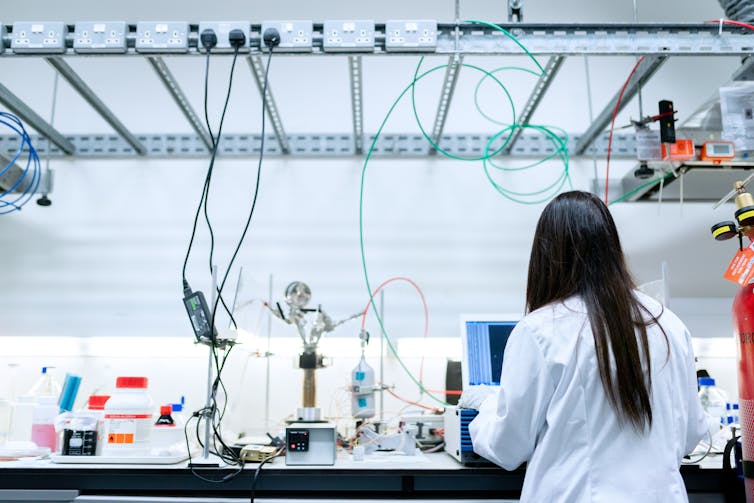Source: The Conversation (Au and NZ) – By Brian Schmidt, Vice-Chancellor, Australian National University

Shuttersetock
This article is part of our series on big ideas for the Universities Accord. The federal government is calling for ideas to “reshape and reimagine higher education, and set it up for the next decade and beyond”. A review team is due to finish a draft report in June and a final report in December 2023.
Education makes Australian citizens healthier, wealthier and more engaged with society. At the same time, government-funded research in higher education drives economic productivity in ways other government funding does not. Together, the future of Australian prosperity depends on the education and research undertaken within its tertiary education system, and especially our universities.
The Australian higher education system has served Australia well over the past 30 years, but it is not fit for the rapid pace of change to which the world will be subjected over the coming decades. If Australia is going to remain the “lucky country”, we are going to have make more of our own luck.
The federal government’s call for “lasting reform” for Australian universities with the Universities Accord offers a timely opportunity to take action.
In my personal submission to the accord process, I outline three big ideas to help reset higher education to deliver the system Australians need and deserve. The first is to provide each Australian with lifetime access to a single higher education system, spanning both university and vocational education.
In this piece I want to focus on my other two big ideas – improving the way we fund and then translate research. These offer some of the biggest and easiest bang-for-buck solutions we can enact.
Australia’s research ecosystem

Martin Adams/Unsplash
Australia’s research ecosystem has become highly reliant on funding via cross-subsidies from international student fees. Currently, Australian government expenditure in research and development – expressed as a fraction of GDP by the OECD as “GBARD” – is the lowest of the world’s advanced economies and is continuing to decline.
Instead, universities now spend more on research (using international student fees) than the government. This does not happen in other advanced economies.
Compounding this is the fact government funding of directed research for national benefit is short-term, ad hoc, not strategically planned across agencies, and is poorly aligned to university planning timescales. Over the past seven years as Vice-Chancellor of the Australian National University, I have seen dozens of different programs across various government agencies come and go with no overall coordination.
Research funding is also not fully integrated with workforce and major equipment needs, and this all leads to shortfalls in key areas of national research need. For example, if we look at critical minerals, the research infrastructure that underpins earth science is completely absent in planning and funding.
Universities, government, and business are not working together on the big research issues facing Australia. To fix this, Australia urgently needs a fully funded core sovereign research capability. We also need to better translate research beyond universities to the real world.
Read more:
The universities accord could see the most significant changes to Australian unis in a generation
We need to identify and properly fund sovereign research
Sovereign research capability is about Australia being able to fund and undertake the research it deems vital to its national interests.
We must identify the core set of sovereign research capabilities necessary for the future security and prosperity of the Australian people. And we must fund these activities in full (including overheads), without the need of cross-subsidies from non-domestic sources. This requires a whole-of-government approach.
This core research should be expected to be uniformly excellent. It should include curiosity-driven research as well as research looking at practical solutions to existing problems (“applied research”). It should also go beyond technological developments to support the vibrancy of Australian democracy and culture.
A large fraction of the sovereign curiosity research money should be competitively allocated via existing bodies, the Australian Research Council and National Health and Medical Research Council grant system.
Read more:
A major review has recommended more independence for decisions about research funding in Australia
We need to make it easier to translate research
In addition to fully funding sovereign research capabilities, we must also rethink how we fund research translation for the public good. This is the process whereby we move research from labs or journals out into the real world.
When we fund applied research, we need to be strongly focused on outcomes. This includes the government directing funding for specific missions in areas of national need. This could be long-term, with timeframes of five to 20 years.
Independent expert-based boards would be given a budget to achieve specific goals within a time horizon, and invest across industry, government and the research sector to achieve these goals. This would replace current schemes for translating top-down government priorities.
In addition, we need a new suite of agile “bottom-up” supports for individuals’ ideas. This would also replace existing research translation schemes, which have typically been “set-and-forget” investments. without an expert stewardship over the ten-year-plus cycle necessary to get globally competitive capabililty.
Projects should be closely monitored and defunded when progress is deemed insufficient. Expert panels could also work with the private sector to rapidly increase investment of such programs when commercially justified.
Funding programs need to pay particular attention to the areas of market failure. Such a system should not crowd out existing private technology transfer, but do things that will not otherwise happen, and better connect industry, government and academia in the research ecosystem.

John Schnobrich/Unsplash
Blue-sky thinking
The foundational research done in universities underpins the sovereign capability of the nation to increase productivity, improve health and wellbeing, remain secure, and to solve and adapt to challenges that face society. This is the research universities do that leads to new products, jobs and industries never envisaged when the research cycle begins.
Work just in my own area of astro-particle physics has underpinned the WiFi, camera, GPS and touch screen of your phone, not to mention many recent startups across Australia.
But most of the value created for Australia is actually through indirect productivity spillovers. These are the people, ideas and capabilities created by Australian research that find their way in thousands of ways into Australia society that allow us to do more for less.
These are hard to measure, and emerge with a considerable lag, but our best estimates are that they are large. Government has a special role in funding this activity, as firms cannot typically capture the benefits of this work.
International education is becoming increasingly globally competitive. The margin from international student fees Australian universities are so reliant on to fund their research is bound to drop over coming decades.
So as part of a sovereign research capacity, Australia should set a minimum level for government sponsored foundational research as a fraction of GDP. This would bring Australia in line with other nations with advanced economies.
And if all universities are expected to undertake excellent research, a base amount of research funding should be made available either through student-based allocations or another mechanism. Alternatively, new types of future higher education institutions could have research dropped from their mission entirely.

ThisIsEngineering/Unsplash
Making our own luck
Australian universities and their research have for many years made Australians’ lives and our world better. The government’s accord process gives us the chance to make sure our universities can continue to deliver on this promise for our future generations.
But we must act and this action must take serious stock in how we fund and translate research in Australia today.
If we fail to value and fund university research in the way that we need, and should, the so-called Lucky Country might just run out of luck.
Professor Brian Schmidt is the 2011 Nobel laureate in physics and Vice-Chancellor of The Australian National University. This article is based on his individual submission to Universities Accord review.
![]()
Brian Schmidt is Vice Chancellor of the Australian National University which is dependent on research funding from government, business, and philanthropy. He has received funding from the Australian Research Council. He is Chair of the Group of Eight, Chair of Fulbright Australia, Chair of the Australian Genomics Advisory Board, and non-executive director of Australia Astronomy Limited. He is a member of the Australian National Science and Technology Council and the Singaporean Academic Research Council.
– ref. Nobel laureate Brian Schmidt’s big ideas for how Australia funds and uses research – https://theconversation.com/nobel-laureate-brian-schmidts-big-ideas-for-how-australia-funds-and-uses-research-204015







